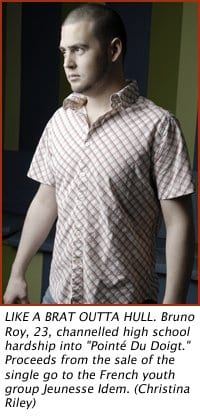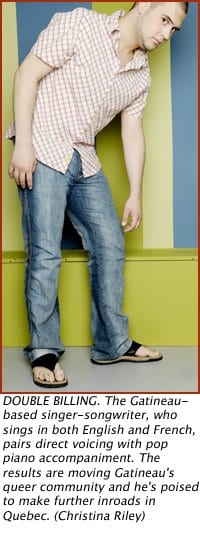Bruno Roy is a knockout — he’s a gracious, talented songwriter, and one sexy specimen. The 23-year-old doe-eyed blond is wholeheartedly grateful for the stirring success that his song, “Pointé Du Doigt” (The Pointed Finger) has garnered thus far among community members in Gatineau. Listening to the track, it’s pretty obvious that there are big things in Roy’s slender frame.
Roy says that he has been writing songs since he was six, and writes in both French and English. Now, he usually composes his songs in the shower. Roy says that “Pointé Du Doigt” wrote itself in about 45 minutes.
The piece is a beautifully crafted song about homophobia that Bruno Roy composed after being approached by Erik Bisson, a counsellor at Jeunesse Idem, a francophone organization for queer youth in the Outaouais region.
Bisson wanted to hear a song about the daily struggles that still exist for members of the queer community, emphasizing the fact that many gays still feel they are the brunt of “the pointed finger”. In the song, Roy reminds us that the feelings of affection in a same-sex relationship are every bit as strong as the feelings in a hetero relationship, in a “if you cut me, will I not bleed?” sort of way.
“Our love may even mean more because we constantly have to fight against others to have it, to be it. It’s so important to bring this love into focus,” says Roy.
The song also pulls from Roy’s own experience with homophobia. His adolescence was peppered with homophobic incidents, even though he came out rather late in life, after high school. The kids at school were merciless. He remembers being attacked by a gang of boys, being sprayed with honey and being locked in the school bathroom.
At the end of it all, the high school kids rigged the prom queen vote so that Bruno would win.
But that’s all behind him now, and in the wake of Roy’s darker days, “Pointé Du Doigt” has been pressed to CD, and has already sold a fistful of few copies as a fundraiser for Jeunesse Idem. The youth group is part of the Bureau Régional d’Action Sida (BRAS), an organization for HIV/AIDS and queer issues tucked away in the basement of the Jules Desbiens Centre in Hull.
Roy says that he realized the emotional magnitude of the song when it became an anthem for the queer youth attending sessions at Jeunesse Idem. The song became a standard at every organized event.
The overwhelming response for the song was felt yet again when Roy was asked to perform at a lesbian wedding, and again at an organized fundraiser for BRAS back in 2004. Roy admits that the first time he performed the song, he had no idea how people would react to it.
“Everyone started to cry during my song at the end, when I was singing my lyrics of hope and encouragement. I looked around and thought, oh my god, it’s beautiful,” says Roy, “It was such a big deal for me to be able to sing for them. I was so thankful to be able to see their faces while performing.”
In the near future a queer Quebec association hopes to begin distributing the song more widely for airplay. Roy hopes to eventually break through the heterocentric pop music scene, at least on a local scale.
“Members of the queer community should not feel forgotten. All the songs currently on the radio are man-woman. I’m ready to represent the other side of that, the reality of that,” says Roy.
Roy realizes, though, that some folks who will never bend on their opinions about homosexuality. In Quebec, he’s encountered a fair number of people who are “okay” with homos, as long as they don’t have to see it.
“It’s hard to hold hands on the streets sometimes, even. Everyone wants to believe it’s so much better, but that’s not necessarily the case. People say, ‘Oh, so you’re a same sex couple, we’ve given you what you want, now shut up and let us be’,” says Roy.
In addition to issues of homophobia, Roy also wants to write more about HIV/AIDS. He feels strongly about the direct correlation between condom use and self-esteem in gay youth, and wants to take his songwriting to various schools in the area.
And of course, he would love to perform live more frequently in the area, and eventually put together a full album if the opportunity arises.
The “Pointé Du Doigt” single is available from the BRAS office at the Jules Desbiens Centre.


 Why you can trust Xtra
Why you can trust Xtra


